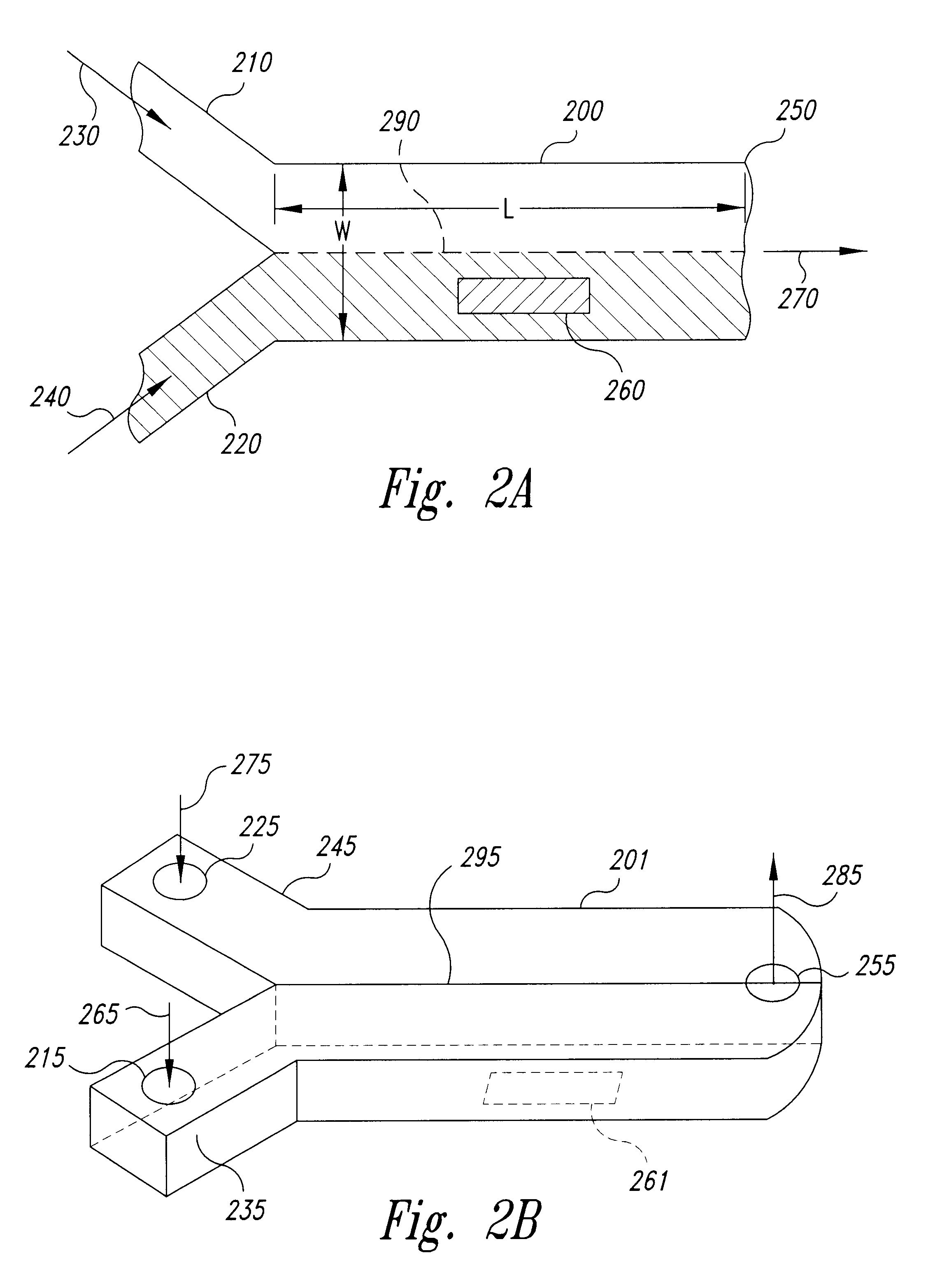Method and device for laminar flow on a sensing surface
a technology of sensing surface and laminar flow, which is applied in the direction of withdrawing sample devices, nanotechnology, material testing goods, etc., can solve the problems of limiting the ability to resolve fast reaction kinetics, increasing sample consumption, and lag in both rise and fall of sensorgrams
- Summary
- Abstract
- Description
- Claims
- Application Information
AI Technical Summary
Problems solved by technology
Method used
Image
Examples
example 1
Representative Flow Cells
This example discloses representative flow cells, as well as the use thereof in the context of this invention. In particular, different Y and .PSI. flow cells are illustrated.
A representative Y flow cell uses the inlets to flow channels 1 and 2, and the outlet to flow channel 2 of a commercially available IFC 4 for a BIAcore 1000 system (BIACORE AB, Uppsala, Sweden). Referring to FIG. 15, sample flow enters Y flow cell 1500 from inlet 1510, and the buffer enters the Y flow cell from inlet 1520. Both sample and buffer exit the Y flow cell via outlet 1530. Both sample and buffer flows are directed into the flow cell by cutting an additional channel in the IFC 4 to allow both sample and buffer to be run through the flow cell simultaneously. The volume of the Y flow cell is 180 nl (i.e., three times the volume of commercially available BIAcore flow cells).
A representative one dimensional ("1D") .PSI. flow cell is depicted in FIG. 16, where sample flow enters .PS...
example 2
Diffusion of Fluid Flows
This example summarizes experiments directed to diffusion of fluid flows as they pass through the representative .PSI. flow cell of Example 1. As mentioned above in the context of FIG. 6, directing fluid flows within a flow cell under laminar flow requires diffusion of the sample to be limited to a region close to the interfere between the flows. If this is not the case, diffusion will interface with the directionality of the sample flow and, rather than distinct flows, a "smear" of flows will result.
In this experiment, diffusion width is determined after about 0.3 seconds, which is the time it takes to transport a molecule through the flow cell of the BIAcore instrument at a flow rate of 10 .mu.l / min. The diffusion width (see FIG. 17A) was measured as the width of a color change of an indicator as measured by ocular inspection with a Panasonic WV-Ks152 video camera and a microscope mounted to the work processor. The diffusion width for different contact time...
example 3
Ion Exchange / On-Line Dialysis
The FIG. 20 shows how an ion exchange or an on-line dialysis may be performed employing the techniques of this invention. FIGS. 20A and 20B illustrate ion exchange with low ion concentration in the adjacent buffer. FIGS. 20C and 20D demonstrate ion exchange when the ion concentration in the adjacent buffer is high. The panels shown in FIG. 20 are for two different flow rates: 10 .mu.l / min in FIGS. 20A and 20C, and 100 .mu.l / min in FIGS. 20B and 20D. The distance between the two interfaces is 12 .mu.m in 20A, 20B, 20C and 20D. Referring to FIG. 20A, the flow rate is 10 .mu.l / min and the concentration of salt and protons for the adjacent buffer is low. The salt concentration in the sample flow decreases to 10% and the proton concentration decreases to 6% of the original concentration. In FIG. 20B the flow rate is 100 .mu.l / min, the salt concentration in the sample flow decreases to approximately 30% of the original concentration, and the proton concentrati...
PUM
| Property | Measurement | Unit |
|---|---|---|
| surface area | aaaaa | aaaaa |
| volume | aaaaa | aaaaa |
| length | aaaaa | aaaaa |
Abstract
Description
Claims
Application Information
 Login to View More
Login to View More - R&D
- Intellectual Property
- Life Sciences
- Materials
- Tech Scout
- Unparalleled Data Quality
- Higher Quality Content
- 60% Fewer Hallucinations
Browse by: Latest US Patents, China's latest patents, Technical Efficacy Thesaurus, Application Domain, Technology Topic, Popular Technical Reports.
© 2025 PatSnap. All rights reserved.Legal|Privacy policy|Modern Slavery Act Transparency Statement|Sitemap|About US| Contact US: help@patsnap.com



